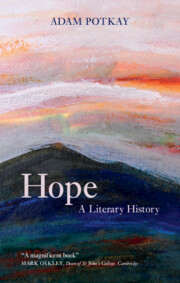Book contents
- Hope: A Literary History
- Hope
- Copyright page
- Contents
- Preface
- Introduction For and Against Hope
- 1 The Limits of Hope in the Ancient World
- 2 Eternal Hope: The Christian Vision
- 3 The Three Hopes of Humanism: Sacred, Profane, and Political
- 4 Something Evermore About to Be: Hope in the Romantic Era
- 5 Later Nineteenth-Century Responses to Romantic Hope
- 6 Modernism: Repetition, Epiphany, Waiting
- Notes
- Acknowledgments
- Index
5 - Later Nineteenth-Century Responses to Romantic Hope
Published online by Cambridge University Press: 27 January 2022
- Hope: A Literary History
- Hope
- Copyright page
- Contents
- Preface
- Introduction For and Against Hope
- 1 The Limits of Hope in the Ancient World
- 2 Eternal Hope: The Christian Vision
- 3 The Three Hopes of Humanism: Sacred, Profane, and Political
- 4 Something Evermore About to Be: Hope in the Romantic Era
- 5 Later Nineteenth-Century Responses to Romantic Hope
- 6 Modernism: Repetition, Epiphany, Waiting
- Notes
- Acknowledgments
- Index
Summary
This chapter addresses five authors who respond to Romantic hopes in indefinite futures: John Stuart Mill, George Eliot, Emily Dickinson, Fyodor Dostoevsky, and Friedrich Nietzsche. In Mill’s late writing on religion, hope in eternal life constitutes a link to Romantic poetry, a motive for taking life seriously, and a wan empirical possibility. In Eliot’s novella The Lifted Veil, blind hope, or our uncertainty about other people and any future we might share with them, may be necessary for love and engagement in this life – or it may be a grievous, fatal error. Along with Dickinson, Eliot supplies a bridge to the Modernists’ largely ironic representation of hope, more or less stripped of its possible virtue. The art of Dostoevsky is also oriented toward emerging Modernism, even as he exposes the ills of modernity, ultimately affirming something akin to Christian hope. Nietzsche sketches a new hope that might rise on the grave of Christianity. Despite his well-known adage on Pandora’s jar – the hope it contains is “the worst of evils” – Nietzsche more often prophesies, in his later writings, the “highest hope” of becoming who one is.
Keywords
- Type
- Chapter
- Information
- Hope: A Literary History , pp. 219 - 264Publisher: Cambridge University PressPrint publication year: 2022

